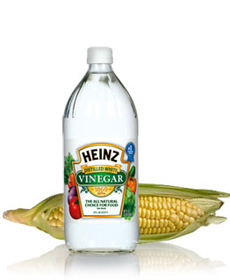
Heinz makes white vinegar from corn. Photo courtesy H. J. Heinz.
|
This article was inspired by HeinzVinegar.com.
|
|
July 2011
|
 |
Uses For White Vinegar
Page 1: In The Kitchen
This is Page 1 of a three-page article on the uses of vinegar. Here, an overview plus uses for white vinegar in cooking. Click on the black links below to visit other pages.
White Vinegar Overview
Vinegar can be made from almost any grain, fruit or starchy vegetable.
White vinegar, also called distilled white vinegar—to keep it distinct from white wine vinegar and white balsamic vinegar—is commonly made from barley, corn, potatoes or rice, plus water. Heinz’s distilled white vinegar, for example, is made from corn.
Vinegar is made from alcohol. The alcohol is converted to full strength vinegar through fermentation. Vinegar is produced from the second fermentation of distilled alcohol made from the base material. The full strength vinegar is then diluted with water to achieve a 5% acidity.
Compared with other types of vinegar, we find distilled white vinegar to be more acrid. While many households use it as a multipurpose cooking and table vinegar—for salad dressing, marinades and the like—the only food purpose we use it for is pickling (and to clean the coffee maker). Other types of vinegar have more flavor. For example, cider vinegar has the added flavor of apples; wine vinegar is made from grapes.
Due to its mild acidity—vinegar is 5% acetic acid—vinegar is versatile as a household cleanser. Vinegar is what great-grandma used for cleaning, before all of the nicer smelling and heavily marketed options began to appear in the market. For those who want a green solution, vinegar is all natural—no added chemicals, dyes or fragrances—and is a fraction of the cost of chemical based products. Truth be told, some modern products do work better. For example, you can use vinegar and water to clean windows, but modern products have anti-streaking ingredients.
Vinegar Trivia
Henry J. Heinz founded his company, H. J. Heinz, in late 1869. His first products were horseradish, pickles and various sauces. The company also manufactured vinegar to preserve its pickles and other condiments. In 1876, the company introduced ketchup, which contains vinegar.
Soon after, the company was the first to package vinegar in individual bottles of vinegar for home use. Before commercial vinegar became commonplace, around 1900, vinegar was made at home. It was fermented in barrels or crocks that were stored in barns or basements.
How is vinegar used?
14 Uses For White Vinegar When Cooking
We prefer more flavorful vinegar for vinaigrettes, marinades, potato salad and other foods. But here are 13 ways that distilled white vinegar helps in the kitchen.
- Poached Eggs. Add two tablespoons of distilled white vinegar added to the water when poaching an egg. It helps the white coagulate.
- Boiled Eggs. Toward the same end, add two tablespoons to the water when boiling eggs. If a shell cracks, the white won’t leak out.
- Wilted Greens. Vinegar can revive wilted leafy vegetables. Perk them up by soaking the greens in cold water with a teaspoon of vinegar.
- Onion Odor. If you have the scent of raw onions on your hands, rub them with a bit of distilled white vinegar. (You can also use stainless steel to remove onion odor. If you have a stainless steel sink or a stainless soup spoon, rub it in your hands.)
- Cruciferous Foods. The cruciferous food group (the family Brassicaceae) are very nutritious and healthy—their components include cancer-fighting antioxidants. But the group, which includes such popular foods as broccoli, cabbage, cauliflower, cress, horseradish, mustard, radish, rapeseed, turnip, wasabi and watercress—which can produce excess intestinal gas—can deter some people. Add a teaspoon of vinegar to the cooking water. It will reduce the gas as it perks up the taste.
- Beans. Adding a teaspoon of vinegar when cooking beans also helps to reduce gassiness. (The better approach is to soak the beans overnight and rinse thoroughly in cool water before cooking. This removes the indigestible complex sugars from the outer coating [oligosaccharides] that cause bloating and gas.)
- Cakes. Add a half teaspoon of distilled white vinegar to cake batter for added moistness and flavor.
- Frosting. Add a drop of white distilled vinegar to make frosting shiny.
- Meringue. Make meringue fluffy by adding a teaspoon of distilled white vinegar for every 3 to 4 egg whites used.
- Deep Fried Food. Eliminate some of the greasiness by adding a dash of distilled white vinegar to the deep fat fryer.
- Rice. Adding a teaspoon of distilled white vinegar to the water.
- Jell-O. Keep molded gelatin desserts and salads from sagging or melting in the summer heat by adding a teaspoon of white distilled vinegar for each box of gelatin used.
- Over-Salted Recipe. If you’ve added too much salt to a recipe, add a spoonful of distilled white vinegar and sugar to correct the taste.
Continue To Page 2: Cleaning With Distilled White Vinegar
Go To Article Index Above
Lifestyle Direct, Inc. All rights reserved. Images are the copyright of their individual owners.

|




